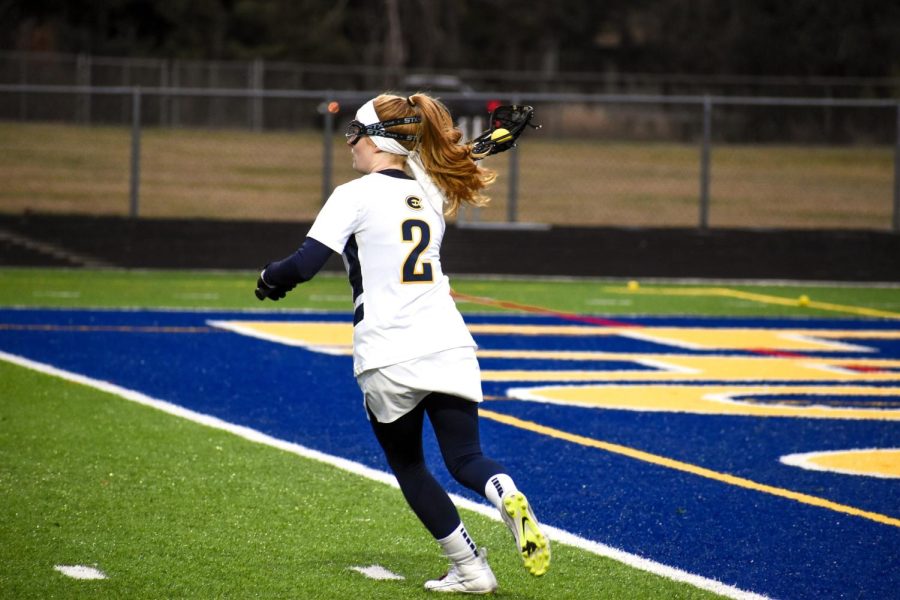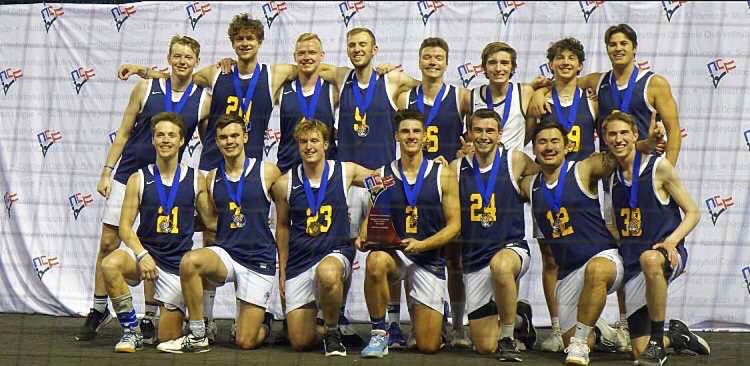When senior Mark Bauer was a freshman, he didn’t immediately catch the eye of Simei Tong, associate professor of mathematics.
“Some students will be good in class; just outstanding,” Tong said.
Bauer, on the other hand, was what Tong described as “calm and cool.” She was pleasantly surprised when he proved himself to be just as capable, if not more so, than the rest in her Calculus II class.
“He was a freshman, and he got a perfect score on the final exam,” Tong said. “I had two sections. That’s 60-70 students. He was the only one to get a perfect score.”
Tong quickly recruited Bauer to her student-faculty research project – the focus of which was creating an emergency evacuation plan for Luther Hospital in Eau Claire.
“I thought, ‘This freshman is very outstanding,'” she said. Tong knew he’d be a great asset to her team.
Outstanding seems to be the right word. There aren’t too many sophomores who can take classes with seniors and blow them out of the water. But Bauer did.
He took both Introduction to Complex Variables and Introduction to Real Analysis II with Tong while he was a sophomore, both of which are 300-level classes that are intended for math majors. In both classes, Bauer was one of the top four students, Tong said. The other three students at the top of those classes were seniors.
Bauer, a major in mathematics and business finance, is now a senior and has already made himself known for his abilities.
Since his first student-faculty research project for Luther Hospital, Bauer has been a part of two other research projects, both of which he started in his junior year.
One was to create math models to plan the most efficient emergency evacuation of a major hospital.
The other was to create math models for the emergency evacuation of Eau Claire County.
He has also earned an internship with the U.S. Department of Homeland Security, and won the prestigious Kell Container Corporation scholarship, which will allow Bauer and Tong to work on another evacuation project, this time for a shopping mall.
As if the research projects and internship aren’t heavy enough tasks for one student to carry, Bauer is also involved in campus organizations.
Formerly an assistant vice president of UWEC’s Math Club, Bauer was elected president last spring.
He was also inducted into the national mathematical honor society, Kappa Mu Epsilon, in the spring of 2009.
“Even coming into the university I’d heard of student-faculty undergraduate research and I thought it’d be something I’d want to do,” Bauer said. “But I guess I did it just to have an opportunity to work along with a professor on new and up-and-coming results to be developing solutions that haven’t been looked at the way that we did it.”
Projects last for the whole school year, and go throughout the summer, providing a lot of time for students like Bauer to work with new materials.
He said that’s not the only perk, either.
“The excitement of solving real life issues … that’s really what drew me to this sort of research,” he said.
Since getting involved with student-faculty undergraduate research projects as a sophomore, Bauer has worked on at least one student-faculty research project every year.
The goal of all of these evacuation projects are to cut down the time it takes to get people out of a building in an emergency.
“When I first tell people that (I work on evacuation plans) it sounds like, ‘Oh, interesting. I never thought to model that with math,'” Bauer said. “But once I explain it to them, it usually makes sense what I do.”
He explains it with ease, but that’s probably due to all of the time he’s spent working with mathematics.
“I’ve had the interest as long as I can remember, even in elementary school,” Bauer explained. “There’s just something about the analytic side of it, and the logical reasoning side of it, that always seemed interesting.”
But to use mathematical models to optimize an evacuation plan for a building is not simple stuff.
With math models, there are two challenges, Tong explained. The first is to summarize all of the information and covert it to a mathematical model. The second is to use the results to their planning and operation of emergency evacuations.
After solving, you need to do an analysis. You have to know what it means, then explain it so people without a background in math can understand it.
“On the major hospital project, Mark started from scratch, from the very beginning,” Tong said.
He built three different models which showed three different ways to evacuate the hospital most efficiently.
One model was to evacuate the buildings by 13 elevators.
The second was a stairwell model which cut down the time it takes to evacuate patients by stairs to 104 minutes.
The third one was called a horizontal evacuation. The major hospital is comprised of several buildings that are connected by skywalks – thus patients, including bedridden patients, evacuate to other buildings of the hospital horizontally. In this model, Bauer was able to cut the time taken to evacuate the eight floors and 12 departments of the building to 27 minutes.
On the Luther project, Mark was in charge of computer programming, where he organized information and converted it to data to produce coefficients and the best solutions.
For the project for the major hospital, Mark was the leader. He worked to contact the hospital, gathered the information, designed the math model and worked with computer software.
He also arranged confidentiality agreements to not disclose the name of the major hospital and gained its trust.
That, Tong said, reflects on the reputation of the university and of the math department.
And all of that work doesn’t go unnoticed. At UW-Eau Claire’s Research Day, the major hospital plan took second place.
For his internship with the U.S. Department of Homeland Security, Bauer spent ten weeks in Albuquerque, N.M. this past summer doing research.
Because of his academic performance and the achievements he made in the research projects, the university’s Office for Research and Sponsor Programs encouraged Mark to apply for the internship.
“I told him, ‘Mark, you can try,'” Tong said. “So he did … I’m so happy to see him rewarded.
“He had two years of experience when he applied,” Tong added. “It’s not surprising that he got the internship.”
Upon receiving the internship, the Department of Homeland Security gave Bauer his choice of labs around the nation to work at. He ended up choosing Sandia National Laboratories in Albuquerque.
“It was the project,” Bauer said. “It seemed interesting and relevant to stuff I’d worked on before, so I chose that project.”
This project “was entirely different” from the evacuation projects he worked on in Eau Claire. In Albuquerque, Bauer worked with full time employees of the Department of Homeland Security as well as other interns. They used a complex adaptive system to work on model infrastructures.
For this project, Bauer worked on a basic exchange model that used a complex adaptive system to build a general model.
The model will be used and adapted to many different situations, Bauer explained. The economy and transactions that go between financial firms are two examples of how the model will be used, he said.
The project wasn’t the only thing that was different, though. Bauer had never been to New Mexico before, or anywhere in the general area.
“I guess the biggest (difference) was the weather,” he laughed. “It was hotter, but less humid; so kind of a trade-off there.”
After all of his work these past few years, Bauer has no intention of slowing down. He plans to go to grad school for financial mathematics and is applying to both masters and Ph.D. programs. He will find out in spring where he has been accepted, and plans to go from there.





